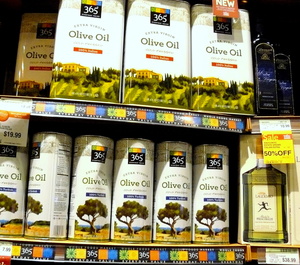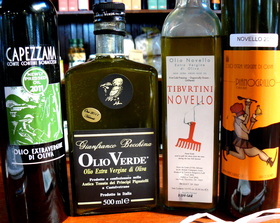Second of two parts.
The United States is the third-largest consumer of olive oil in the world, a market approaching two billion dollars a year, yet has some of the loosest laws on earth concerning olive oil purity or honest labelling. The Food & Drug Administration and the US Department of Agriculture have no budget for testing, let alone enforcing laws against fraud.
The problem, as journalist Tom Mueller describes in his new book, Extra Virginity, is the huge reward, with vrtually no risk, in mislabelling the oil. "Extra Virgin" has all but lost its meaning.
 I spoke with Mueller by phone recently and he reminded me that olive oil is a truly amazing substance. "We shouldn't be scaring people away," he said. Indeed there's been a huge increase in olive oil sales in the US, thanks to publicity about the health-enhancing properties of the Mediterranean Diet.
I spoke with Mueller by phone recently and he reminded me that olive oil is a truly amazing substance. "We shouldn't be scaring people away," he said. Indeed there's been a huge increase in olive oil sales in the US, thanks to publicity about the health-enhancing properties of the Mediterranean Diet.
Olive oil is, as Mueller puts it, "an age-old food with space-age qualities that medical science is just beginning to understand." There's even an intriguing chemical relationship between EVOO and the anti-inflammatory Ibuprofen. The tragedy is the temptation to dumb it down, by stripping from real Extra Virgin oil the specific characteristics (fruity, peppery, bitter) that make it the "real thing."
Does it have to be Italian? Hardly. In fact, Whole Foods now sells Extra Virgin Olive Oil from Turkey as well as California. (Many Whole Foods oils are DOP-labelled as well, to certify their origins.) Does it have to come from gnarled trees growing on a hillside in Tuscany? Hardly. Excellent oils are produced on vast, quasi-industrial groves in Spain, as well as Sicily and Puglia, even if the bottling plants put them in jars with Tuscan scenery.
There's a lot of unnecessary mystery in the production of olive oil. Those great stone mills are ancient history. Today's harvested olives are ground up with large metal burrs, the paste stirred in huge tanks and the liquid extracted by centrifuge. Trader Joe's website, in a convoluted, 1,900-word article on olive oil, calls this step "centrifugetion." The TJ's description continues: "Because oils are mixed together to achieve balance and style, judging oil by the country of origin has passed into legend. Nowadays, oils from all growing regions and countries can be blended together to produce tastes and styles that have specific uses." So TJ's lowest-cost oil is labeled "Packed in Italy," which doesn't reveal much about its origins.
 Ironically, the US is not part of the International Olive Council, a 50-year-old rule-making body set up by the United Nations, relying instead on standards set by the US Department of Agriculture. Still, some surprising results from the University of California, Davis, which is in the heart of America's olive-oil producing region. In a report a year ago, UC Davis researchers found that 69 percent of imported "extra virgin" olive oil (and 10 percent of domestic oil) wasn't what it pretended to be. Even the best-known brands showed signs of adulteration (blended with inferior grades of olive oil or cheaper oils from soybeans, hazelnuts and sunflower seeds).
Ironically, the US is not part of the International Olive Council, a 50-year-old rule-making body set up by the United Nations, relying instead on standards set by the US Department of Agriculture. Still, some surprising results from the University of California, Davis, which is in the heart of America's olive-oil producing region. In a report a year ago, UC Davis researchers found that 69 percent of imported "extra virgin" olive oil (and 10 percent of domestic oil) wasn't what it pretended to be. Even the best-known brands showed signs of adulteration (blended with inferior grades of olive oil or cheaper oils from soybeans, hazelnuts and sunflower seeds).
The lone import to receive top ratings on all points was Costco's Organic Extra Virgin Oil, which sells for one fifth the price of competing brands.
As it happens, you can taste some new, 2011-vintage premium olive oils at ChefShop, the specialty food supplier at 1425 Elliott Ave West in Seattle.
And if you want to watch Mueller talk about olive oil, there's a YouTube video here.
Extra Virginity, by Tom Mueller, WWNorton, 238 pages, $25.95
Leave a comment